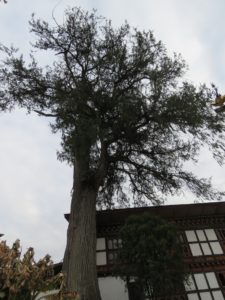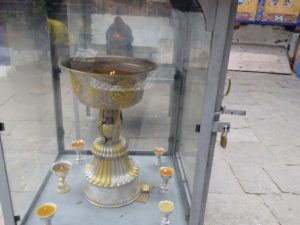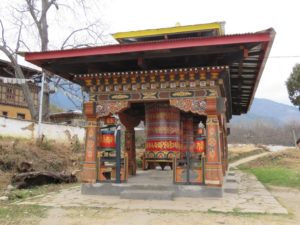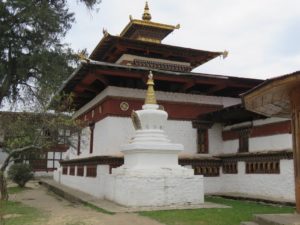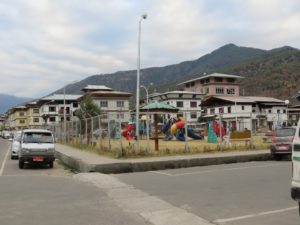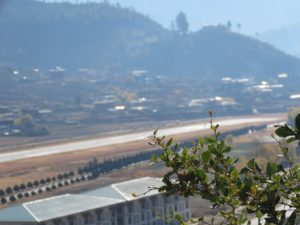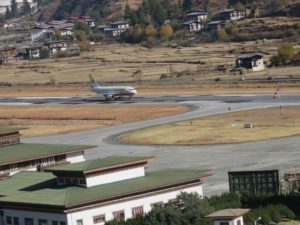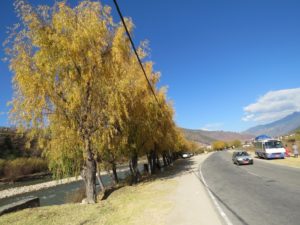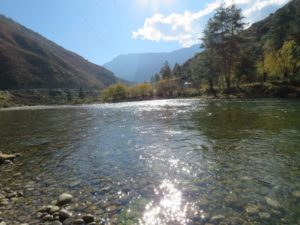Bhutan: Beauty Untamed – Paro

The drive from Punakha to Paro is pleasant. We reached a bit late in the evening quite tired with all the sight-seeing but were pleasantly surprised to watch traditional folklore and dances and we danced too with the dancers. The dances were related to a shepherd’s song while grazing yaks, archery competition, songs by women about their life, mask dances etc. It was a chilly winter evening and all the dances were performed with us sitting around a bonfire. It was one of the most entertaining cozy evening of the vacation.
If there is one thing in Paro that anyone with decent fitness should not miss is the Trek to Taktshang Monastery popularly known as the Tigress nest. It is a historical monument which is as fascinating in history as it is about its location and beauty. It is approximately 10,000 + feet above sea level, built initially without any blue print.
Regarded as one of the most holy sites in Bhutan, one only realizes how minuscule they are in front of the nature on completion of the trek to visit this place of worship. It is said that Guru Padmasambhava, the Indian saint came to Bhutan in 8th century AD and flew into this cave from Kurtoe Singye Dzong in Easter Bhutan, riding on a tigress. People near to the vicinity of Taktshang in those days, said, they saw the tigress residing in the cave. Hence the name Tigress nest. The area was frequented by malicious evil spirits, hence to subdue them, Guru Padmasambhava took the form of Guru Dorji Drolo (one of the eight manifestations). We started the trek early morning, took a sturdy stick for some support, since the trek involves steep uphill climb, followed by almost 700 stairs one way. The morning was filled with mist and sometimes it seemed the clouds had come down and were shaking our hands wishing us a good trek 🙂
Slowly and steadily we started climbing, and reached the cafeteria somewhere in middle of the trek after an hour. The place has clean toilets with ice cold water, piping hot tea and food. But instead of sitting there, we headed up eager to visit the monastery. The trail has flags at some locations and a prayer wheel. It is said to go in clockwise direction of the wheel and proceed to the monastery. After a climb of 2 hours huffing and puffing, we reached the monastery gate and stared at it in awe of the beauty. I had never felt this humble my entire life. Once inside the monastery, we removed our shoes and visited all the holy chambers.
By luck, our small group was also able to go deep down to the cave where the tigress was actually seen. It was a difficult climb almost 2 floors down on not so sturdy ladders but completely worth it. Never felt this thrilled in life. It was short-lived, as DH blurted, what if an earthquake happens and we are stuck here forever. As steadily as I had climbed down to see the cave, I hurried up to come out of the cave. So much for my thrill.
After the visit, we simply sat and enjoyed the valley views, the clouds kissing our cheeks, the gentle sound of water falling somewhere close, the chirping of birds and the sound of silence. We were at peace with our minds and heart.
The climb down was easy, with a refreshing tea, snacks at the cafeteria and a much needed break to the aching legs. Within an hour we were down, greeted by the rest of the group who had preferred to stay back.
There is a small market below the monastery where one can buy souvenirs at good rates.
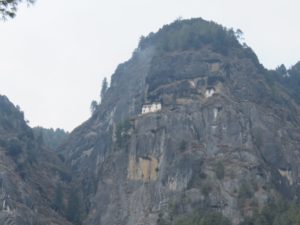 Taktshang Monastery
Taktshang Monastery
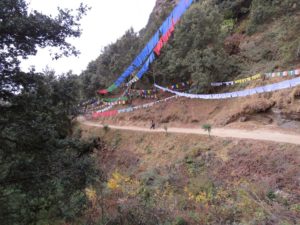

Post the monastery, we visited a fortress (Drukgyel Dzong) which is now being restored but was in ruins since a major fire in 1950s. It was built in the 16th century to commemorate a victory over the invading Tibetan forces. The ruins seemed to whisper in my ears that it was a strong well-built fort at one point of time.


Next, we visited an old monastery which dates back to 7th century, Kyichu Lhakhang. it is believed that Guru Rinpoche himself visited here and concealed many a spiritual treasure. The inner hall contains one an ancient, original statue of JowoSakyamuni dating back to the 7th century, believed to be cast around the same time as its counterpart in Lhasa, Tibet. The temple also contains large statues of Guru Rinpoche and Guru Kurukulla, towering at a height of 5 meters. Don’t miss to see the beautiful big prayer wheels, lamps and the two orange trees in the temple courtyard, which are said to bear fruits throughout the year.
Paro offers a lot of adventurous sports, so if you are into it, do try the river rafting, treks, mountain biking, etc. You will be delighted to know how much nature can offer you back.
Unfortunately, since our half day went in the hike, we could not explore the Nation Museum located in a round fortress called Ta Dzong. But a quick glimpse through it made us aware of the flora and fauna and historical artifacts of Bhutan. I was particularly scared by a big crocodile that is put up in the museum for display. It actually seems quite real :p
After a refreshing trek and visits to the different sites, it was time for the most important activity of the day – Shopping.
I split from the group, wandering alone through the streets of Paro, clicking moments about the daily chores being done by the people. I was delighted to see, big beautiful playground for kids, with ample open space and activities like swings, jungle gym, slides, etc. in them.
Next, I moved on to explore the souvenir shops. There is variety of traditional arts like masks, ceramics, wood and slate carvings, handmade paper crafts like greeting cards of 8 sacred symbols, metal art, postal stamps, magnets, thangka’s (holy scrolls), etc. Apart from these there are shops which sell exquisitely embroidered shawls, sweaters and Kiras. I would suggest to bargain in case you wish to buy some gifts for your near ones from the shops. I got a few things for my family and friends and exited the area.
A trip to Paro is incomplete unless you witness an airplane landing at the Paro airport. We were lucky to capture the moment in our minds as we saw a Druk airlines plane doing the same on our way back to Phuentsholing. It is difficult to maneuver the plane while take-off and landing on Paro airport, since it is located between two valleys and has to balance against the winds to have a seamless entry and exit. Only handful pilots have this experience. Do check the Druk airlines schedule beforehand and wait at the airport to witness this beautiful moment.


